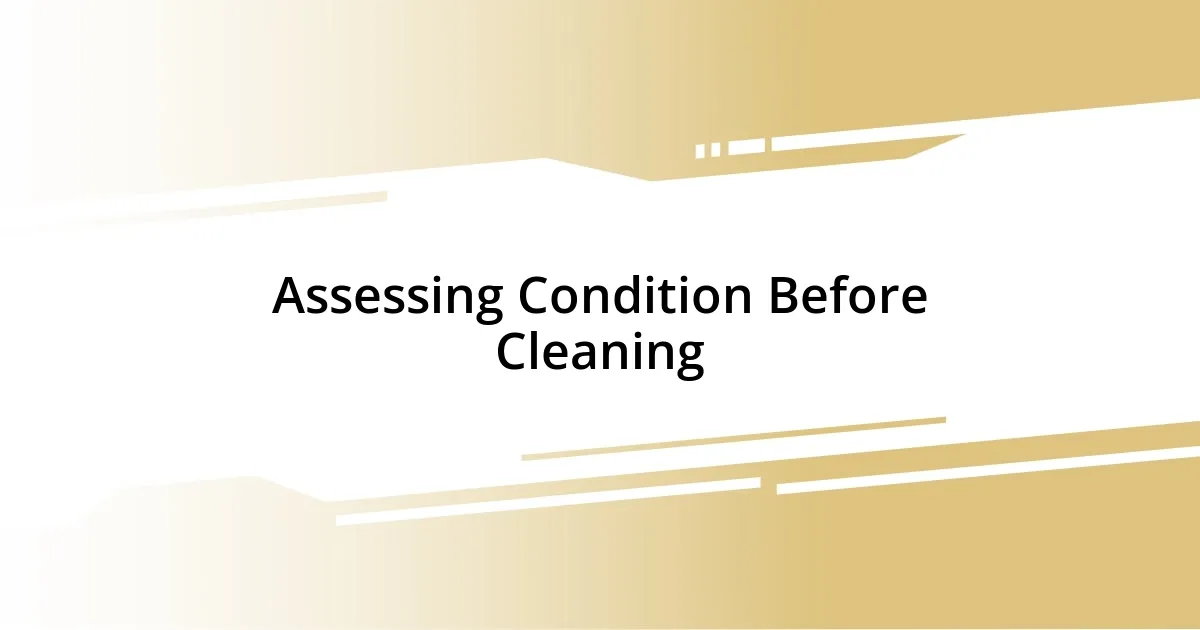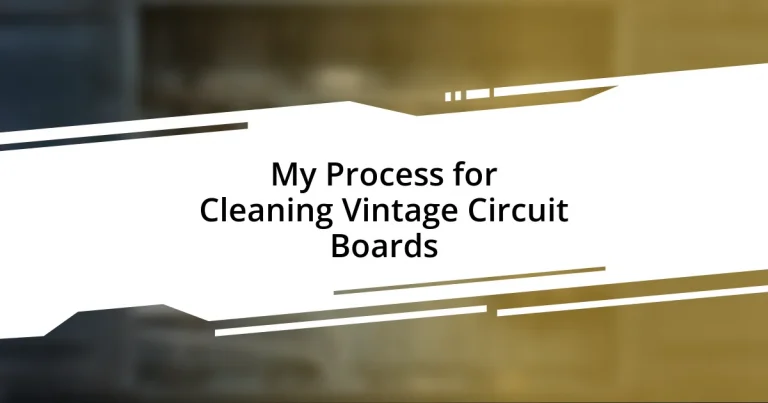Key takeaways:
- Thoroughly assess the condition of vintage circuit boards before cleaning, looking for corrosion, cracked components, and melted traces.
- Gather essential cleaning supplies like isopropyl alcohol, soft brushes, and lint-free cloths to ensure an effective cleaning process.
- Document disassembly and reassembly steps meticulously to avoid mistakes and ensure proper functionality after cleaning.
- Perform regular maintenance and inspections, storing boards in a cool, dry place to extend their lifespan and prevent damage.

Understanding Vintage Circuit Boards
Vintage circuit boards are fascinating relics of technological history, often showcasing craftsmanship that feels almost artisanal. I remember my first encounter with an old Atari circuit board; the intricate pathways and aged soldering sparked a curiosity in me that I’ve nurtured ever since. Isn’t it intriguing how these boards, once cutting-edge, now tell stories of a past era?
Many vintage circuit boards were built to last, using components that possess a unique charm, but they also require special care. I found myself mesmerized while carefully inspecting a 1970s stereo receiver’s circuit board, noticing the variations in materials and designs. It makes you wonder—what innovations might we overlook today that could become treasures in the future?
As I’ve delved deeper into the world of vintage electronics, I’ve realized that understanding these boards involves recognizing their unique design philosophies. For instance, the use of through-hole components in older boards often gives them a robust strength that newer surface-mount technology lacks. Isn’t it fascinating how these design choices reflect the engineering mindset of their time?

Assessing Condition Before Cleaning
Before diving into the cleaning process, I firmly believe it’s crucial to thoroughly assess the condition of a vintage circuit board. I usually start by inspecting for visible signs of deterioration, such as corrosion or cracked components. The first time I evaluated an old radio’s circuit board, I was struck by how the corrosion hinted at the device’s history and previous environmental conditions—it felt like piecing together a mystery!
Next, I consider the functionality of the board. Are there melted traces or burnt components? Once, I came across a vintage computer board that looked promising, but a closer look revealed damaged traces that needed careful repair before any cleaning could commence. Going through that experience taught me that weighing functionality against superficial appearance is essential to avoid causing further damage during cleaning.
I always remind myself that these vintage pieces are not just circuit boards; they carry stories and memories. By carefully assessing their condition, I feel like I’m preserving a slice of history for future generations to appreciate. It’s this emotional connection that drives my meticulous approach to assessing each board.
| Condition Aspect | What to Look For |
|---|---|
| Corrosion | Check for any signs of rust or oxidation that can affect functionality. |
| Cracked Components | Inspect for any visible damage on chips or solder joints. |
| Melted Traces | Look for areas where traces may be burnt or damaged, requiring repair. |

Gathering Necessary Cleaning Supplies
When it comes to cleaning vintage circuit boards, having the right supplies is essential. I remember the first time I attempted this; I scrambled around my workshop, feeling unprepared. Trust me, it can be quite a task if you don’t have everything you need at hand. Creating a checklist of supplies based on my experience has been invaluable. Here’s what I consider essential for the cleaning process:
- Isopropyl Alcohol (99%): Perfect for dissolving grime without hurting the components.
- Soft Brush: A gentle bristle brush helps to dislodge dust without scratching the surface.
- Cotton Swabs: Ideal for targeting smaller areas when cleaning.
- Lint-Free Cloths: Great for drying and avoiding any residue.
- Plastic Spudger: Useful when you need to carefully scrape off stubborn residue.
- Compressed Air: Helps blast away dust without direct contact.
Gathering these items beforehand creates a smoother process, allowing me to focus on the task instead of hunting down supplies midway through. I can’t emphasize enough how a well-organized workspace and the right tools make a world of difference. It’s almost meditative to have everything set out, ready for the careful restoration of these pieces of tech history.

Step-by-Step Cleaning Process
After gathering my supplies, I begin by removing the circuit board from its housing. I always approach this task with a touch of reverence; these boards are often intricately connected to their enclosures, and I’ve learned that careful disassembly prevents damage. During one memorable restoration, I hesitated as I unscrewed the last bolt—what if this old stereo board held secrets I might disrupt? I’ll tell you, my heart raced a bit, but being methodical pays off. Taking my time to document the placement of any screws or connectors helps me later during reassembly.
Once the board is free, I take it to a well-lit area and inspect it again, just to ensure I haven’t overlooked anything. I grab my soft brush and start gently brushing away loose dust. The first time I did this, I was amazed at how much grime came off; it felt like unearthing a lost treasure beneath layers of neglect. It’s important to be patient here. I work in small sections, almost like I’m tracing the board’s history, each stroke unearthing clues of its past.
Next, I dip a cotton swab in the isopropyl alcohol and focus on particularly dirty spots, such as around solder joints. I remember feeling a sense of satisfaction as I watched the grime dissolve—almost like seeing the board rejuvenate before my eyes. I can’t help but wonder, do others feel the same thrill when they bring these pieces back to life? For me, it’s a connection to the craftsmanship of the past, as I meticulously restore functionality to something that once sparked joy for its original owner.

Drying and Preventing Damage
Once I’ve cleaned the board thoroughly, the drying process becomes crucial. I always place the circuit board on a lint-free cloth to absorb any residual moisture. During my early attempts, I would sometimes rush this step, thinking a quick air dry would suffice, but I learned the hard way—any leftover moisture could lead to corrosion or even short circuits later on. Now, I make sure to give it ample time to air dry completely, often finding it helpful to leave it in a warm, dry area for at least an hour.
I can’t stress enough how important it is to inspect the board after it’s dried. I’ve found that taking a moment to closely examine it under a bright light reveals any remaining spots I might have missed. There was one instance when I overlooked a small, stubborn piece of residue. After reassembling everything, I was left with a malfunctioning board and a sinking feeling in my stomach. It’s a painful reminder that thorough checks post-drying really pay off.
In addition, I always avoid using any heat sources like hair dryers. Not only can they create hot spots that might damage delicate components, but they also risk blowing dust into sensitive areas. Instead, I use compressed air gently during the drying phase to dislodge any particles. Has anyone else experienced that moment of panic when you realize you might have damaged something you loved? I swore my heart would stop until I saw that the board was safe. Taking the time to ensure that the board is dried properly is worth every minute—it preserves its integrity and protects the history embedded within.

Reassembling and Testing Boards
Reassembling the circuit board is always a moment filled with anticipation for me. It’s like piecing together a puzzle while reliving the board’s story. I carefully reference the notes I took during disassembly, ensuring that every screw and connector finds its rightful place. The first time I did this, I made a couple of mistakes that led to a non-responsive board. That experience has taught me just how crucial it is to be meticulous in reassembly.
When I finally complete the reassembly, I can’t help but feel a surge of excitement, usually accompanied by a hint of anxiety. Will it work? I connect the board back to its power source and flip the switch. In those moments, my heart races. I remember one particular instance when I had restored an old gaming console. The moment it powered up and the screen flickered to life, I felt an electric blend of joy and nostalgia, as if I had resurrected a piece of my childhood. It’s fascinating how one flick of a switch can evoke so many memories.
After the initial test, I always run through a series of functional checks, especially on vintage boards with multiple components. I’ve found that patience during this stage is key. There was a time I skipped some testing, thinking everything looked good, only to discover a faulty capacitor later. It made me appreciate how vital it is to thoroughly test every part of the board. Aren’t those moments of realization what make this hobby so rewarding? Being methodical not only saves the disappointment of malfunction but also reinforces the love I have for reviving these outdated yet cherished pieces of technology.

Maintenance Tips for Longevity
Maintaining vintage circuit boards requires consistent care to extend their lifespan. One practical tip I’ve adopted is to store them in a cool, dry place—preferably in anti-static bags. Early on, I neglected this, and a humid environment led to oxidation on one of my favorite boards. The regret I felt was profound; I learned that simple preventative measures can save you from heartbreak later.
Regular inspections are also key to longevity. I make it a habit to check my boards every few months, looking for signs like dust accumulation or loose connections. I distinctly remember finding a tiny crack in a solder joint on a rare board during one of these checks. It was a close call! The moment I discovered it felt like a small victory—acting early prevented a bigger issue down the road. Isn’t it amazing how a little vigilance can go a long way?
Lastly, I’ve found that documenting every cleaning and maintenance session boosts my confidence in the board’s condition and my process. Initially, I would clean and forget—only to worry later if I’d done it right. Now, I keep a log that details my actions and observations. This way, I can track what works best over time. It feels empowering to have a personal history tied to each board, making me more connected to the pieces I love. Don’t you think our relationships with these vintage treasures grow deeper when we invest time and care into them?














